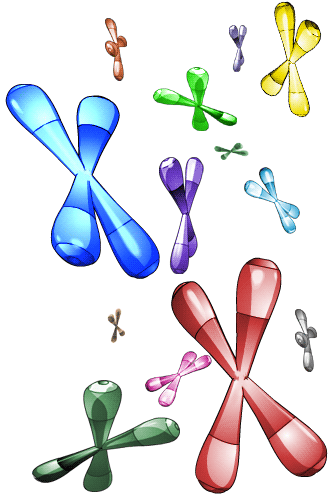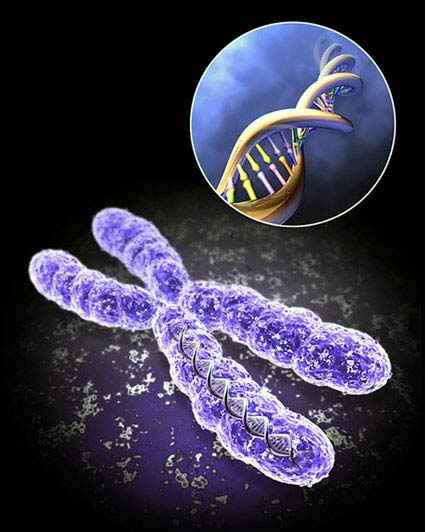Арсланова_Г_А_и_др_Essential_English_for_Biology_Students (1). Kazan federal university
 Скачать 7.01 Mb. Скачать 7.01 Mb.
|
Text 3.2 Chromosomes ■ Essential targets: By the end of this text you should be able to ● explain how DNA is folded in a chromosome ● describe the structure and function of centromeres ● discuss the role of telomeres. Pre-reading ■ With your partner, consider the following questions before looking at the text. Then quickly scan the text to see if you were right. What do you know about chromosomes? What is mitosis? What is meosis? What kind of molecules are called histones? Exercise A. Match the words with their definitions:
■ Read the given text and make your essential assignments: What's in a chromosome? A  chromosome consists of hundreds or thousands of genes (a gene is the basic unit of inheritance), and specialised parts that are thought to be important to the chromosomes stability and function. The deoxyribonucleic acid (DNA) that makes up the genes is packaged with the aid of proteins to form a complex structure. Chromosomes also contain small amounts of ribonucleic acid (RNA). chromosome consists of hundreds or thousands of genes (a gene is the basic unit of inheritance), and specialised parts that are thought to be important to the chromosomes stability and function. The deoxyribonucleic acid (DNA) that makes up the genes is packaged with the aid of proteins to form a complex structure. Chromosomes also contain small amounts of ribonucleic acid (RNA). DNA is packaged in chromosomes Each human chromosome contains one very long DNA molecule which unravelled would measure about 4.8 cm in length. The total length of DNA in the nucleus of a human cell has been estimated to be about 2.2 m. This poses a packaging problem: how does a chromosome measuring оn average 6 µm long contain about 8000 times its length of DNA? The answer is that chromosomal DNA is intricately folded and is tightly bound to protein molecules called histones. Histones are small proteins that are rich in the amino acids lysine and/or arginine. The complex formed between DNA and histones is called chromatin. Chromatin takes up stain and is visible in non-dividing nuclei. Individual chromosomes can be seen under the light microscope only during cell division (mitosis or meiosis). Nucleosomes - the basic structural unit Each DNA molecule is wound around histones arranged in groups of eight known as octamers. The DNA and octamers form bead-like structures known as nucleosomes. Positively charged groups on the side-chains of the histones form strong ionic bonds with negatively charged phosphate groups in the backbone of the DNA. In each nucleosome, a length of DNA containing about 150 base pairs is wrapped around the octamer. Another histone molecule attached to the outside of the nucleosome binds DNA to the octamer. The nucleosome is regarded as the basic unit of the structure. The linker region, the stretch of DNA between the nucleosomes, varies in length from 14 to over 100 base pairs. Nucleosomes fold to form solenoid fibres More histones in the linker region help to fold the thread of DNA and nucleosomes (the nucleosome fibre) into a tightly coiled structure called a solenoid. The solenoids are thought to be further looped and coiled around non-histone proteins called scaffolding proteins. The precise details of this higher level of folding are not known. The centromere E  ach chromosome has a centromere which usually appears as a constriction when the chromosomes condense during mitosis and meiosis. The position of the centromere can be used to distinguish between different chromosomes. ach chromosome has a centromere which usually appears as a constriction when the chromosomes condense during mitosis and meiosis. The position of the centromere can be used to distinguish between different chromosomes.Centromeres do not contain any genes. However they do contain large segments of highly repetitive DNA, called alpha satellite DNA. This is thought to play a significant role in centromere function. The centromere contains the kinetochore. This is a densely staining structure that attaches the chromosome to the spindle apparatus during nuclear division. Centromeres control the distribution of chromosomes during cell division. Chromosomes that do not have centromeres cannot divide. Telomeres Telomeres are located at the ends of chromosomes. They consist of DNA and protein. The telomeres appear to play a vital role in maintaining the stability of the chromosomes, 'sealing' the ends of linear DNA. They have been likened to the tips of shoelaces, and have a similar function: to stop the DNA fraying. They also seem to play an important role in regulating cell division. Under normal circumstances, telomeres become shorter and shorter with each cell division. When the telomeres have shortened to a certain critical length, the cell stops dividing. If the telomeres are removed, the chromosome disintegrates. It is thought that the ageing process may be linked to telomere damage. Telomeres: a role in cancer? Telomeres contain repeating sequences of bases which are synthesised with the help of an RNA-containing enzyme called telomerase. Telomerase activity is suppressed in normal human somatic (body) cells. However, in cancerous cells, telomerase is active and maintains the telomere length so that the cells continue to divide. It is thought that this abnormal retention of the telomeres is involved in the development of some types of cancer. ■ Glossary of essential terms for you to know
■ Your Essential Assignments: Quick check: What is a nucleosome? Centromeres contain no genes. What is their main function? Why have telomeres been compared with the tips of shoelaces? Suggest Russian equivalents for the following word combinations:
Fill in the gaps with the words and expressions from the text: 1. The artificial chromosome remains … and functions as …. 2. Chromosomes also contain small amounts of …. 3. Chromosomal DNA … and … to protein molecules called histones. 4. The complex formed between … is called chromatin. 5. Each DNA molecule … histones arranged in groups of eight known as octamers. 6. The DNA and octamers form … known as …. 7. Centromere appears as … when the chromosomes condense during mitosis and meiosis. 8. Centromeres do not contain any …. IV. Find English equivalents for the following word combinations:
V. Answer the following questions. Use all information given before: What is a nucleosome? Centromeres contain no genes. What is their main function? Why have telomeres been compared with the tips of shoelaces? What risks might be associated with changing the length of telomeres in body cells? What is the total length of DNA in the nucleus of a human cell? What are histones? What happens if the telomeres are removed? When and where was the first artificial human chromosome made? How could synthetic chromosomes be used? How is DNA packaged in chromosomes? VI. Read and translate the short text without a dictionary: Fact of life: In February 1997, the first artificial human chromosome was made by Dr Huntington Willard and his colleagues from the Case Western Reserve University in Cleveland, Ohio. According to their report, this achievement should: '... open the door to a whole new avenue of research in chromosome biology and gene therapy.' A synthetic chromosome containing a specific gene could be introduced into human cells to treat a genetic disease. The artificial chromosome remains independent within host cells and functions as an 'extra' or accessory chromosome. VII. Food for thought: In January 1998, a paper in the journal Science explained how telomeres can be lengthened by introducing a gene for an enzyme called telomerase reverse transcriptase (hTRT). This enzyme causes cells to produce active telomerase, the enzyme that repairs telomeres. Suggest how techniques for manipulating telomere length might be used to treat age-related diseases and cancers. What risks might be associated with deliberately changing the length of telomeres in body cells? VIII. Translate into English using all the active possible: Искусственная хромосома остается независимой внутри клетки хозяина и функционирует в качестве дополнительной хромосомы. Ген является основным звеном наследственности. ДНК упаковывается с помощью белков и образует сложную структуру. Хромосомальная ДНК замысловато складывается и тесно связывается с белковыми молекулами, называемыми гистонами, которые богаты аминокислотами лизином и/или аргинином. Этот комплекс, образованный между ДНК и гистонами, называется хроматином. Отдельные хромосомы могут быть увидены только во время деления клетки. Положительно заряженные группы на боковых цепях гистонов образуют сильные (крепкие) ионные связи с отрицательно заряженными фосфатными группами в основании ДНК.Каждая хромосома имеет центромер, который обычно появляется в качестве ограничения, когда хромосомы уплотняются во время деления клетки (митоза или мейоза). Центромеры контролируют распределение хромосом во время деления клетки. Теломеры поддерживают стабильность хромосом, закрывая концы линейной ДНК. Процесс старения связан с повреждением теломера. IX. Use a monolingual English dictionary and write down what could the words given below mean: to treat; host; aid; complex; distribution; vital; to maintain; abnormal. X. Read the text and render it in English: Сколько лет проживем? Скоро каждый желающий сможет узнать, сколько лет ему отпущено природой. Разработанный испанцами тест измеряет длину ДНК на концах хромосом. Эти участки, называемые теломерами, защищают ДНК от повреждений. Со временем теломеры становятся слишком короткими, в результате чего клетка перестает делиться и умирает, что ускоряет процесс старения. На основе этого был сделан вывод, что люди с короткими теломерами живут меньше. Исследователи считают, что тест получит широкое распространение в ближайшие 5-10 лет и поможет в борьбе с раком, сердечно-сосудистыми заболеваниями и болезнью Альцгеймера. XI. Prepare a short presentation reflecting the following issues: ▪ discuss the role of telomeres; ▪ describe the structure and function of centromeres; ▪ explain how DNA is folded in a chromosome. ■ Have Some Fun! Biologist Joke! Enzymes are things invented by biologists that explain things which otherwise require harder thinking. | |||||||||||||||||||||||||||||||||||||||||||||||||||||||||||||||||||||||||||||||||||||||||||||||||||||||||||||||||||||||||||||||||||||||||||||||||||||||||||||||||||||||||||||||||||||||||||||||||||||||||||||||||||||||||||||||||||||||||||||||||||||||||||||||||||||||||||||||||||||||||||||||||||||||||||||||||||||||||||||||||||||||||||||||||||
